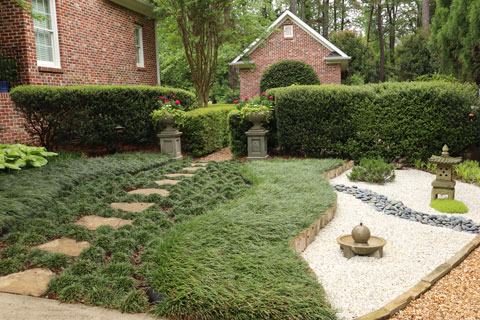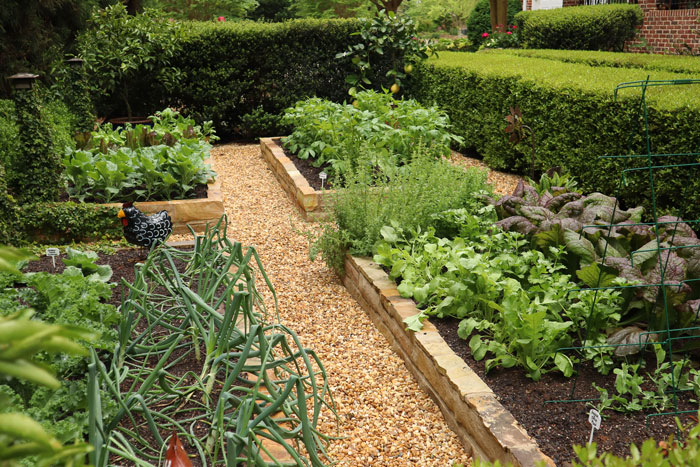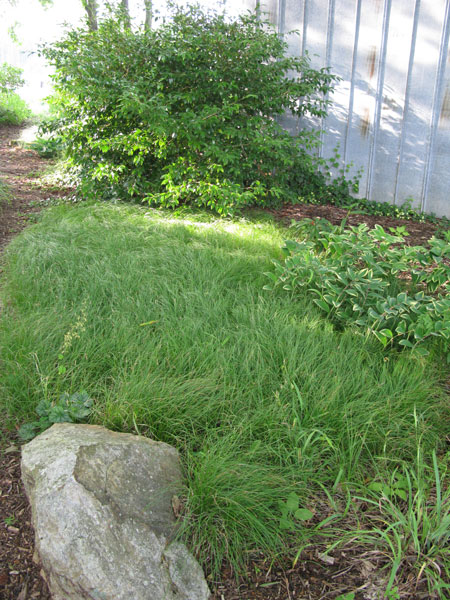1/1/2021
Re-Envisioning the American Lawn
Helen Newling Lawson

The post-World War II building boom brought mass-production to American houses. With the rise of suburbs like Levittown, Pennsylvania, the same standardization came to our concept of the ideal landscape. We’re talking about lawns and a lot of them.
Besides being somehow tied to the idea of the American Dream and home ownership, turf grass lawns offer plenty of practical benefits.
“There’s a reason turfgrass works,” says Shannon Currey, marketing director for Hoffman Nursery, a grower specializing in ornamental grasses. As a durable walking or recreational surface, it largely goes unmatched.
Photo Credit: Helen Lawson.
Shannon also points out that grasses may be a more natural part of the landscape than we realize. “In a lot of natural ecosystems, [grasses] are often the ground layer,” she explains. “In the ratio of grasses to other forbs or woody plants, the grasses are dominant.”
Lyle Collins, a landscape designer in Atlanta, Georgia, who’s helped clients reduce their lawn size, also sees benefits to lawns from a design standpoint—when used mindfully.
“I only want the lawn where it serves the best purpose. If it’s guiding the eye, if it’s enough space to play on, and maybe connect one space to the next,” Lyle says.
Shannon agrees, “We can’t vilify lawns, but have them be intentional … it’s not leftover space.”
Research from the American Society of Agronomy details other benefits to turfgrass, such as the ability to control erosion and dust; absorb pollutants; sequester carbon; recharge groundwater and protect water quality; provide cooling; dampen noise and glare; and diminish fire risk.
But that same report also lists issues with turfgrass, including increased water and pesticide use, and fertilizer runoff. Land devoted to lawns doesn’t produce food for people or wildlife. Plus, all that mowing means an increase in fossil fuel use, air pollution and mowing-related injuries.
Putting it in industry lingo, Lyle says, “[Lawns] require so many inputs … either chemicals, water, time, maintenance, money.
 Selling Customers on Smaller Lawns
Selling Customers on Smaller Lawns
While lawns are considered a traditional approach, gardeners over the age of 35 are more receptive to the idea of reducing lawn size than younger homeowners, according to the “Future of Gardening” survey conducted in 2019 by the National Garden Bureau.
Photo Credit: Helen Lawson
Maybe new or future homeowners still have their ideas of home ownership tied to big lawns—or maybe just haven’t spent enough weekends mowing—but replacing turfgrass with more varied plantings offers enough benefits to resonate with any age group. Depending on your customers’ priorities, you might want to promote replacing lawns with plants that:
• Support wildlife by providing food or shelter
• Attract birds without needing to fill and clean feeders
• Host bees, butterflies and other pollinators
• Provide edible crops to feed the family
• Provide visual interest
• Require less maintenance
Lyle says that homeowners who outsource their lawn care may not appreciate how much goes into maintenance. But he’s found that encouraging clients to replace their lawn with a mix of seasonally interesting and lower-maintenance plants often fosters a passion for gardening, on top of reducing upkeep costs.
“They may never have used their yard before because they just paid somebody to cut it, but now they get up in the morning and walk around with their coffee just to see what’s changed. And now it’s an engaging part of your space, not just ‘outside,’” he says.
 Photo credit: Hoffman Nursery.
Photo credit: Hoffman Nursery.
And guess what: a customer who’s more engaged with plants is also likely to shop for more.
While Lyle sells his clients on the idea of a smaller lawn for less maintenance, he does have to educate homeowners on how to care for their new plants.
Here’s an idea: Turn that learning curve into a reason to stay in touch with customers on a regular basis, such as with a monthly email offering landscape care checklists.
Balancing Upfront and Ongoing Costs
Lyle’s spin on reducing maintenance costs is a clever way to address the biggest hurdle to planting something other than turfgrass: the cost of installation.
Shannon says, “I say right up front one of the challenges I think IGCs have, especially if you want a true lawn-like look, is getting plants in quantities and sizes that are affordable.”
Her suggestion? Be ready to add liners to your product line-up. “Asking homeowners to put in finished sizes as a replacement for larger lawn areas [is] unrealistic for anyone except those with a huge budget.”
Upsides and Upsells
If we can think of a pandemic as having an upside, one positive might be the new appreciation homeowners have for their landscapes.
“Now everybody’s home,” Lyle says. “They’re starting to realize having a place to gather outdoors is key.” He likes hardscape for creating usable areas, but tells clients, “It doesn’t have to connect to grass because that’s static.” He prefers bringing life and movement to the yard with ornamental grasses and plants that attract butterflies.
Once your customers create outdoor living spaces, outfitting that space is a chance to sell high-ticket items like outdoor kitchen equipment, firepits, furniture and lighting. For customers looking to get into edible gardening quickly, raised planting beds can be placed right over the lawn. That means raised bed kits, growing accessories, tools and watering necessity sales. The opportunities can be endless. GP
Helen Newling Lawson is a freelance writer and marketing consultant for the green industry. Follow her #Gardenspotting adventures on Instagram at @SpotOn_Gardens or email her at hlawson@spotoncommunications.net.
Plant List
So what plants should you sell customers looking for a lawn alternative? Shannon Currey from Hoffman Nursery advises asking the customer whether they’re going for function or looks.
“What do we mean when we say lawn alternative?” she asks, pointing out the difference between functional and aesthetic replacements. “All of these things are covering the ground. Is it just something low-growing, like a groundcover? Do you want it to look like a turf grass lawn? Those suggest different sets of plants.”
Using Shannon’s approach of form following function, you might suggest these plants to fit different goals:
Withstand foot traffic:
Buffalo grass (Bouteloua dactyloides)—A rhizomatous turf grass alternative that spreads quickly to form a dense, mowable carpet. Needs full sun, but tolerates drought, heat and low fertility. Zones 4 to 8.
Habiturf—A native grass blend of buffalo grass, blue grama (Bouteloua gracilis) and curly mesquite (Hilaria belangeri) developed by the Wildflower Center for dry regions of Texas, Oklahoma, New Mexico and Arizona.
Mowable:
Sedges—Like the choices above, sedges like Carex pensylvanica can be mowed, albeit far less often than turf (a few times per year, max).
Chemical-free:
Clover/microclover—Instead of needing chemicals or fertilizers added, clover (Trifolium repens) fixes nitrogen in the soil. It also resists dog urine stains.
Flowering:
Ajuga—JC Raulston Arboretum recently experimented with creating a flowering lawn using low-growing, drought-tolerant plants that would knit together and tolerate light foot traffic, using bugleweed in combination with delosperma, phlox, thymes and viola.
Shade tolerant:
Dwarf mondo grass—Atlanta-based Landscaper Lyle Collins has used this for multiple clients, but recommends 4-in. pots planted nearly side by side due to dwarf mondo’s slow-growing nature.